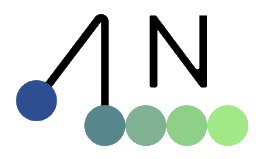Sites (Abstract Markers)#
Sites are abstract reference points that don’t participate in physics simulation or collision detection. They are lightweight markers used for:
Sensor attachment points (IMU, camera, raycast origins)
Frame of reference definitions for measurements
Debugging and visualization reference points
Spatial tendon attachment points and routing
Overview#
Sites in Newton are implemented as a special type of shape with the following properties:
No collision: Sites never collide with any objects (shapes or particles)
No mass contribution: Sites have zero density and don’t affect body inertia
Transform-based: Sites have position and orientation relative to their parent body
Shape types: Sites can use any geometric primitive (sphere, box, capsule, etc.) for visualization
Visibility: Sites can be visible (for debugging) or invisible (for runtime use)
Creating Sites#
Sites are created using the add_site() method on ModelBuilder:
builder = newton.ModelBuilder()
# Create a body
body = builder.add_body(mass=1.0)
# Add a site at body origin
imu_site = builder.add_site(
body=body,
key="imu"
)
# Add a site with offset and rotation
camera_site = builder.add_site(
body=body,
xform=wp.transform(
wp.vec3(0.5, 0, 0.2), # Position
wp.quat_from_axis_angle(wp.vec3(0, 1, 0), 3.14159/4) # Orientation
),
type=newton.GeoType.BOX,
scale=(0.05, 0.05, 0.02),
visible=True,
key="camera"
)
Sites can also be attached to the world frame (body=-1) to create fixed reference points:
builder = newton.ModelBuilder()
# World-frame reference site
world_origin = builder.add_site(
body=-1,
xform=wp.transform(wp.vec3(0, 0, 0), wp.quat_identity()),
key="world_origin"
)
Alternative: Using Shape Methods with as_site=True#
Sites can also be created using shape creation methods (add_shape_sphere, add_shape_box, add_shape_capsule, add_shape_cylinder) by passing as_site=True. This is particularly useful when programmatically generating shapes or conditionally creating sites:
builder = newton.ModelBuilder()
body = builder.add_body(mass=1.0)
# Create sites using shape methods
sphere_site = builder.add_shape_sphere(
body=body,
radius=0.05,
as_site=True,
key="sphere_marker"
)
box_site = builder.add_shape_box(
body=body,
hx=0.1, hy=0.1, hz=0.1,
as_site=True,
key="box_marker"
)
# Useful for conditional creation
is_sensor_point = True
shape_idx = builder.add_shape_sphere(
body=body,
radius=0.05,
as_site=is_sensor_point, # Conditionally a site
key="measurement_point"
)
When as_site=True, the shape is automatically configured with all site invariants (no collision, zero density, collision_group=0), regardless of any custom configuration passed
Importing Sites#
Sites are automatically imported from MJCF and USD files, with optional control over what gets loaded.
MJCF Import#
MuJoCo sites are directly mapped to Newton sites, preserving type, position, orientation, and size:
<mujoco>
<worldbody>
<body name="robot">
<!-- Sites with various types and orientations -->
<site name="sensor_site" type="sphere" size="0.02" pos="0.1 0 0"/>
<site name="marker_site" type="box" size="0.05 0.05 0.05"
quat="1 0 0 0" rgba="0 1 0 0.5"/>
</body>
</worldbody>
</mujoco>
By default, sites are loaded along with collision and visual shapes. You can control this behavior with the parse_sites and parse_visuals parameters:
builder = newton.ModelBuilder()
# Load only collision shapes and sites (no visual shapes)
builder.add_mjcf("robot.xml", parse_sites=True, parse_visuals=False)
# Load only collision shapes (no sites or visual shapes)
builder.add_mjcf("robot.xml", parse_sites=False, parse_visuals=False)
USD Import#
Sites in USD are identified by the MjcSiteAPI schema applied to geometric primitives:
def Xform "robot" (
prepend apiSchemas = ["PhysicsRigidBodyAPI"]
) {
def Sphere "imu_site" (
prepend apiSchemas = ["MjcSiteAPI"]
) {
double radius = 0.02
double3 xformOp:translate = (0.1, 0, 0)
uniform token[] xformOpOrder = ["xformOp:translate"]
}
}
Similar to MJCF import, you can control whether sites and visual shapes are loaded using the load_sites and load_visual_shapes parameters:
builder = newton.ModelBuilder()
# Load only collision shapes and sites (no visual shapes)
builder.add_usd("robot.usda", load_sites=True, load_visual_shapes=False)
# Load only collision shapes (no sites or visual shapes)
builder.add_usd("robot.usda", load_sites=False, load_visual_shapes=False)
By default, both load_sites and load_visual_shapes are set to True.
Using Sites with Sensors#
Sites are commonly used as reference frames for sensors, particularly the FrameTransformSensor which computes relative poses between objects and reference frames.
For detailed information on using sites with sensors, see Sensors.
MuJoCo Interoperability#
When using SolverMuJoCo, Newton sites are automatically exported to MuJoCo’s native site representation:
from newton.solvers import SolverMuJoCo
# Create a simple model with a site
builder = newton.ModelBuilder()
body = builder.add_body(mass=1.0, I_m=wp.mat33(np.eye(3)))
site = builder.add_site(body=body, key="sensor")
builder.add_joint_free(body)
model = builder.finalize()
# Create MuJoCo solver (sites are exported by default)
solver = SolverMuJoCo(model)
Sites are exported with their visual properties (color, size) and can be used with MuJoCo’s native sensors and actuators. To disable site export, pass include_sites=False to the convert_to_mjc() method if calling it manually.
Implementation Details#
Sites are internally represented as shapes with the ShapeFlags.SITE flag set. This allows them to leverage Newton’s existing shape infrastructure while maintaining distinct behavior:
Sites are filtered out from collision detection pipelines
Site density is automatically set to zero during creation
Sites can be queried and filtered using the Selection API with shape-frequency operations
This implementation approach provides maximum flexibility while keeping the codebase maintainable and avoiding duplication.
See Also#
Sensors — Using sites with sensors for measurements
Custom Attributes — Attaching custom data to sites and other entities
newton.sensors — Full sensor API reference
USD Parsing and Schema Resolver System — Details on USD schema handling

